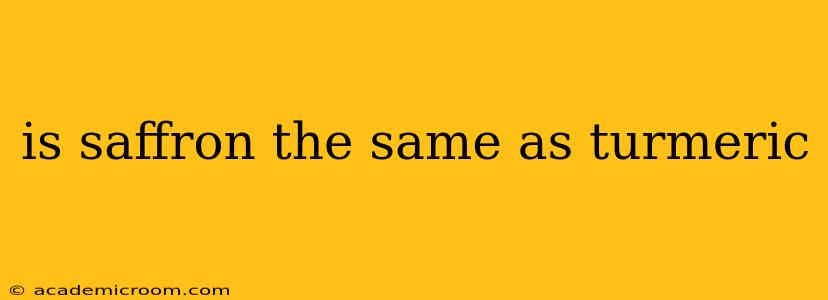Saffron and turmeric are both vibrant spices with rich histories and potent health benefits, but they are not the same. While both originate in Asia and boast striking colors, their origins, appearances, and chemical compositions differ significantly, leading to vastly different culinary and medicinal applications. This article will delve into the key distinctions between these two popular spices.
What is Saffron?
Saffron is derived from the Crocus sativus flower, specifically its crimson-colored stigmas and styles. These delicate threads are hand-harvested, making saffron incredibly labor-intensive and thus, expensive. Its distinctive flavor is often described as earthy, slightly bitter, and intensely aromatic, with hints of honey and metal. The color it imparts to dishes is a rich, golden yellow.
What is Turmeric?
Turmeric, on the other hand, is a rhizome—a root-like stem—of the Curcuma longa plant. It's far more readily available and significantly cheaper than saffron. Turmeric powder, a common household staple, is a deep golden-orange color and possesses a warm, slightly peppery, and earthy flavor.
Key Differences Between Saffron and Turmeric:
Here's a table summarizing the key differences:
| Feature | Saffron | Turmeric |
|---|---|---|
| Source | Crocus sativus flower's stigmas | Curcuma longa plant's rhizome |
| Cost | Very expensive | Relatively inexpensive |
| Color | Deep golden-yellow | Deep golden-orange |
| Flavor | Earthy, slightly bitter, aromatic | Warm, slightly peppery, earthy |
| Active Compound | Safranal, picrocrocin | Curcumin |
| Culinary Use | Often used sparingly for flavor and color | Used more liberally in curries and dishes |
What are the Health Benefits of Saffron and Turmeric?
Both spices boast potential health benefits, although research is ongoing and more studies are needed to definitively confirm many claims:
Saffron's Potential Health Benefits:
- Antioxidant properties: Saffron contains antioxidants that may help protect cells from damage.
- Mood enhancement: Some studies suggest saffron may be helpful in improving mood and reducing symptoms of depression. However, more research is needed.
- Appetite suppression: Some evidence indicates that saffron may help regulate appetite. However, more research is needed.
Turmeric's Potential Health Benefits:
- Anti-inflammatory properties: Turmeric's active compound, curcumin, is known for its potent anti-inflammatory effects.
- Antioxidant properties: Like saffron, turmeric is rich in antioxidants.
- Potential benefits for brain health: Some research suggests curcumin may improve brain function and reduce the risk of neurodegenerative diseases. However, more research is needed.
Is Saffron a Substitute for Turmeric? And Vice Versa?
No, saffron and turmeric are not interchangeable. Their distinct flavors and colors make them unsuitable substitutes for each other in most recipes. Saffron's intense flavor and high cost make it a spice used sparingly to enhance the overall dish, while turmeric is used more liberally for both flavor and color.
What are the Different Types of Saffron?
There aren't different "types" of saffron in the sense of distinct plant varieties. However, the quality and grading of saffron vary depending on factors such as the number of stigmas per gram, the color, and the level of moisture. Higher-grade saffron typically commands a higher price due to its superior quality and intense flavor and color.
Can I Use Saffron and Turmeric Together?
Yes! The combination of saffron and turmeric can create a complex and flavorful dish, blending their unique characteristics for a truly unique taste experience. However, remember to use saffron sparingly due to its cost.
In conclusion, while both saffron and turmeric are valuable spices with potential health benefits, they are distinct and should not be considered interchangeable. Their unique properties lend themselves to different culinary applications and offer a wide range of flavors and colors in various cuisines.
